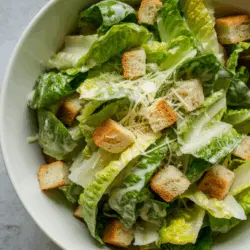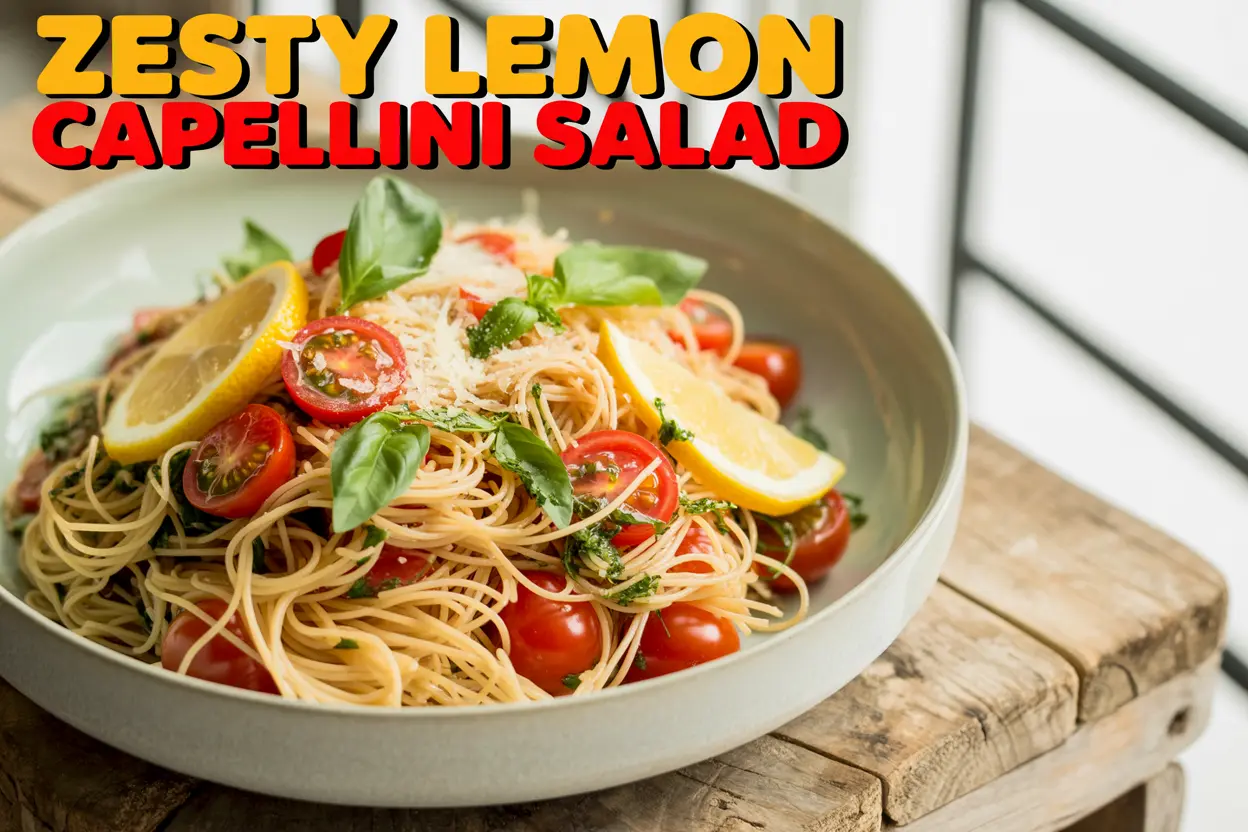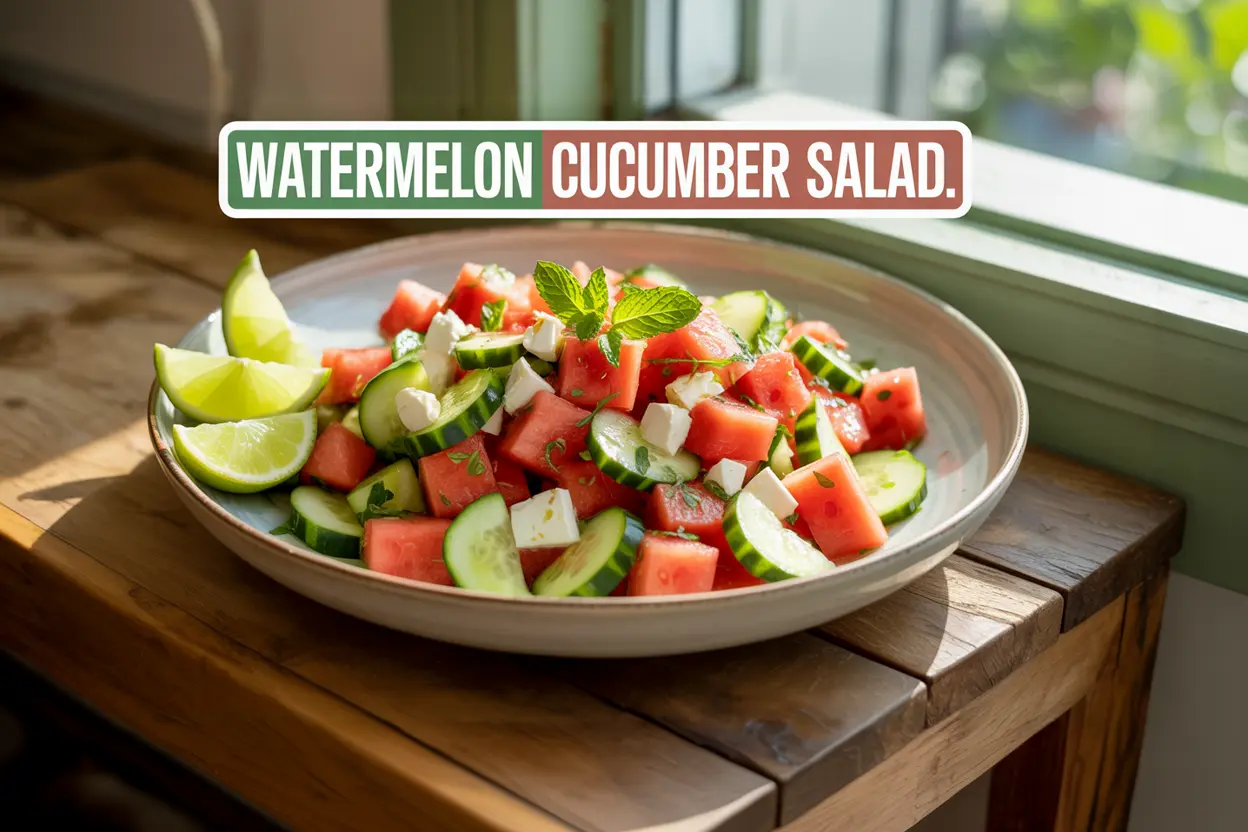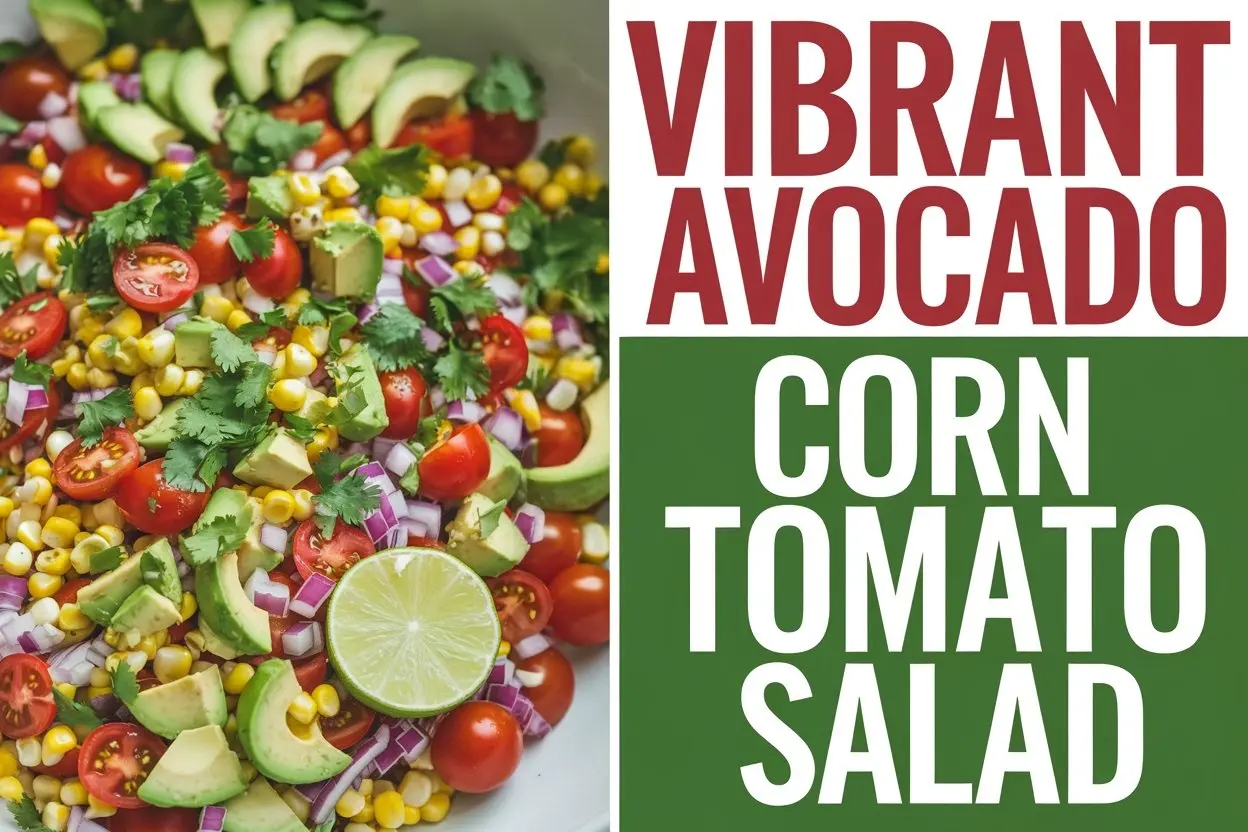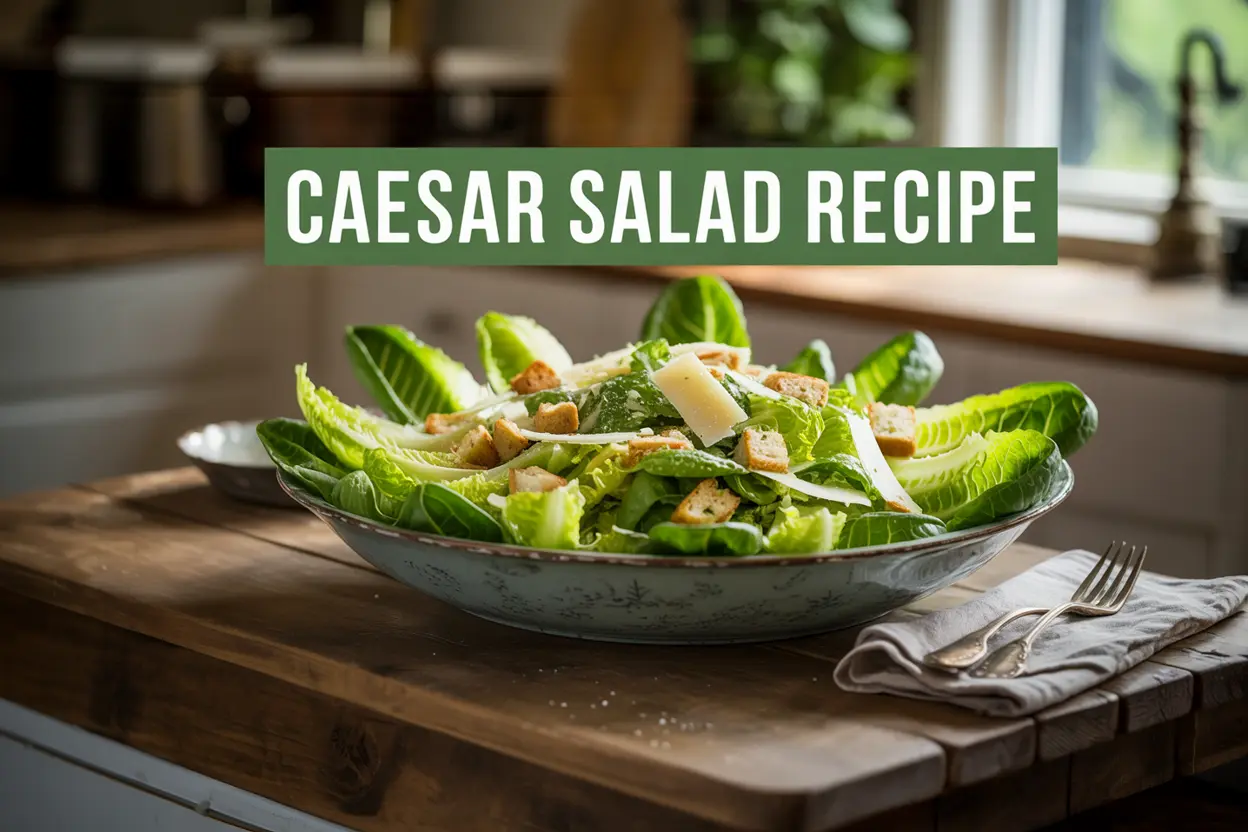
Caesar salad recipe holds an undeniable allure. There’s just something irresistible about the way its creamy dressing clings to crisp romaine, and how each bite perfectly balances garlicky croutons with salty Parmesan. Whatever its secret, this dish has earned a permanent spot in my kitchen-and it’ll likely find one in yours too.
In this guide, I’ll walk you through how to make the ultimate Caesar salad recipe from scratch. We’ll cover the essential ingredients, unlock the secrets behind the classic dressing, and even share tips to prep ahead without losing that perfect crunch. Whether you’re serving it solo or pairing it with grilled chicken, this recipe promises both exceptional flavor and surprising simplicity.
Table of Contents
Why I Keep Coming Back to This Caesar Salad Recipe
Memories Around the Caesar Bowl
I still remember the first time I tried to make a Caesar salad recipe at home. I must’ve been 16, fresh off watching a Food Network marathon, convinced I could replicate restaurant-level Caesar salad with nothing but store-bought dressing and iceberg lettuce. It was…awful. But it sparked a journey. Years later, I cracked the code, and today, this Caesar salad is a non-negotiable on our table-especially for dinner parties or nights when I want something that feels indulgent without being fussy.
The thing I love most about this Caesar salad recipe is that it lets simple ingredients shine. It’s not about reinventing the wheel-it’s about doing each element just right. Crisp romaine hearts, homemade croutons toasted in garlic-infused oil, and that dreamy dressing made with egg yolk, lemon juice, and just a touch of anchovy for umami. Add a snowfall of freshly grated Parmesan and suddenly, salad feels like the main event.
For a dish that’s so often overlooked as “just a side,” the Caesar salad packs surprising depth. It’s creamy, tangy, salty, and crunchy in every bite. And with some grilled chicken, like in this chicken cutlets with basil and burrata or honey balsamic glazed chicken thighs, it turns into a full, satisfying meal.
This Caesar salad recipe never fails to impress. Whether you’re serving it as a light main or a vibrant starter, it always delivers bold, balanced flavor. Looking to round out your meal? Serve it with this flavorful feta cranberry pasta salad for a refreshing contrast, or cozy up with a bowl of turkey meatballs in creamy spinach sauce for something heartier. Either pairing makes for a memorable and satisfying spread.
Classic Caesar Salad Ingredients & Variations
What Ingredients Are in a Caesar Salad?
At its core, the Caesar salad recipe is a celebration of a few simple but bold components. The foundation? Romaine lettuce-ideally the inner hearts, for their crispness and tender bite. Next comes the crunch: golden, garlicky croutons, preferably made from a sturdy loaf like sourdough or a rustic baguette. And of course, the finishing touch-shaved or grated Parmesan cheese, which melts slightly against the dressing, adding salty depth and texture.
The true essence of this Caesar salad recipe lies in its dressing. You’ll need egg yolks, fresh garlic, lemon juice, Dijon mustard, olive oil, and anchovy fillets or paste. These ingredients combine to form that signature creamy dressing, perfectly balanced with tang and richness. While optional for some, the anchovy is a crucial flavor enhancer, seamlessly blending in to provide savory notes that make the salad irresistible.
Here’s a quick look at the ingredients that make this Caesar sing:
| Ingredient | Purpose |
|---|---|
| Romaine Hearts | Crunchy base of the salad |
| Garlic Croutons | Texture & garlicky flavor |
| Parmesan Cheese | Salty umami kick |
| Egg Yolks & Lemon | Creamy & tangy dressing base |
| Anchovy & Dijon | Depth & signature Caesar flavor |
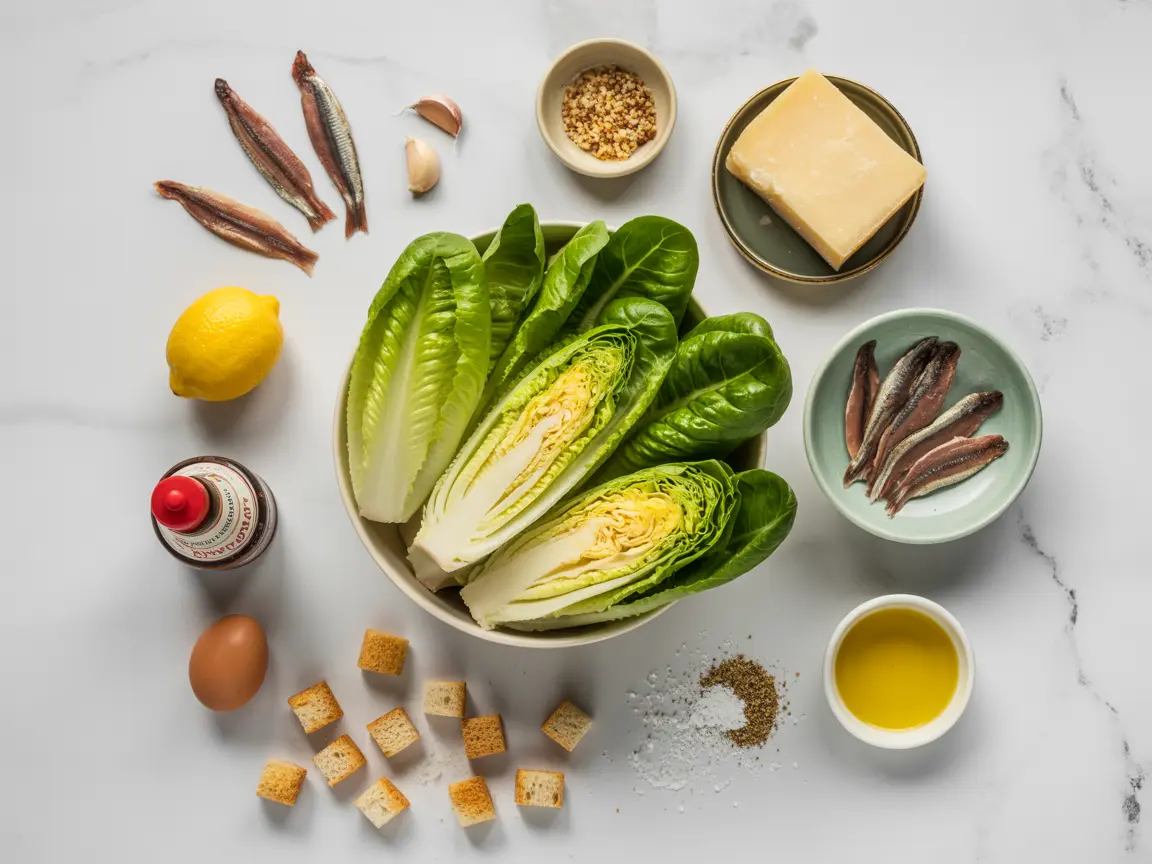
Want to make this even better? Pair it with a warm side like this stuffed chicken thigh mozzarella for a total flavor upgrade.
What Makes It “Classic”?
The “classic” Caesar salad recipe goes beyond ingredients-it’s about ratios and technique. A real Caesar should be boldly flavored, lightly coated (never drenched), and freshly tossed. That’s what sets it apart from pre-made grocery store versions or heavy restaurant interpretations.
Authenticity starts with raw egg yolk, not mayonnaise. It includes finely chopped anchovies-not fishy, but deeply savory. The dressing is whisked slowly to emulsify, creating a velvety texture without needing cream. And the romaine? Only tossed just before serving, so it stays crisp.
You’ll know you’ve nailed a classic Caesar when each bite is crisp, tangy, salty, and clean. There’s no need to complicate it-this dish thrives on balance. And if you want to branch out, you can take a fresh cue from this zesty lemon capellini herb salad for a summery twist on texture and acidity.
Making the Caesar Salad Dressing from Scratch
Step-by-Step Creamy Caesar Dressing
If you’ve never made your own Caesar salad dressing, you’re in for a game-changer. It might sound fancy, but it’s honestly one of the simplest-and most rewarding-dressings you’ll ever whisk together. This creamy Caesar dressing recipe delivers that signature tangy-salty richness you can’t get from a bottle. And you don’t need a blender or food processor-just a bowl and a whisk.
Begin by creating a paste from finely minced garlic and anchovy fillets (or use anchovy paste for convenience). Into this, whisk an egg yolk, Dijon mustard, and a generous squeeze of lemon juice. This combination forms your vibrant, savory, and sharp flavor base. Gradually drizzle in olive oil, whisking continuously and vigorously until the mixture emulsifies. Finish by stirring in freshly grated Parmesan cheese, a pinch of salt, and black pepper.
Here’s a quick walkthrough:
| Step | Action |
|---|---|
| 1 | Mash garlic & anchovy into a paste |
| 2 | Whisk in egg yolk, lemon juice, and Dijon |
| 3 | Slowly add olive oil while whisking to emulsify |
| 4 | Stir in grated Parmesan, salt, and pepper |
This dressing keeps well in the fridge for up to three days; just be sure to store it in a tightly sealed jar. I often prepare a batch with homemade oyster crackers to accompany Caesar salad, adding a delightful textural twist.
Substitutes & Customizations
Now, let’s say you’re not into anchovies or you’d rather skip raw egg yolk-no worries. You can still nail a tasty Caesar salad recipe with a few smart swaps.
- Egg-free: Use mayonnaise as the base for richness and texture.
- Anchovy-free: Sub with Worcestershire sauce, which still adds umami.
- Lighter option: Try Greek yogurt for a tangy, creamy spin that keeps it healthy.
- Vegan twist: Blend cashews with lemon juice, garlic, and nutritional yeast for a dairy-free version.
Play with the ratio to get the flavor and consistency just how you like it. And for a rich pairing idea, this dressing is killer over roasted veggies or next to slow-cooked cowboy beans for a smoky, hearty contrast.
Perfecting Your Caesar Salad Every Time
How to Serve It Best
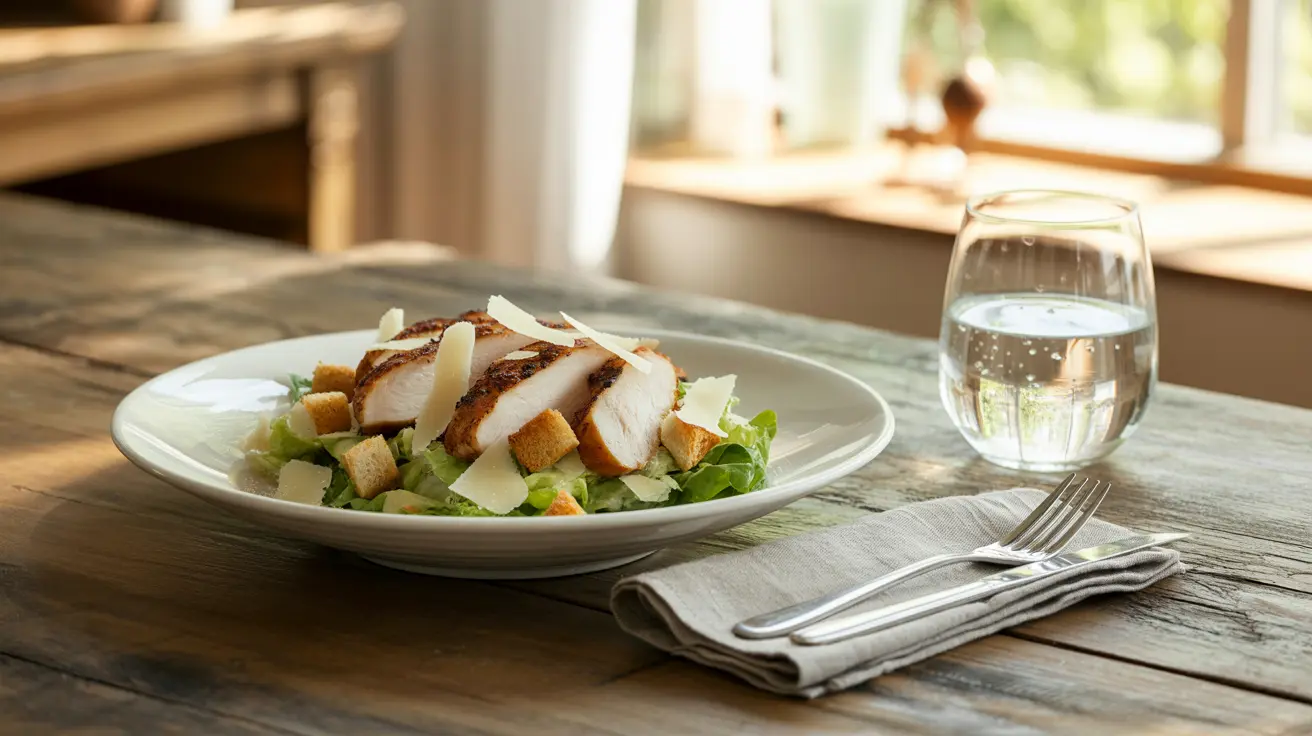
Once you’ve tossed your romaine with that creamy homemade dressing and topped it with golden croutons and Parmesan, you’re not done just yet. How you serve your Caesar salad recipe can elevate it from a good side dish to a true centerpiece.
For a classic presentation, serve it in a chilled bowl-this helps keep everything crisp longer. I like to shave the Parmesan right over the top just before serving, so it doesn’t melt into the greens too early. For extra flair, add a few anchovy fillets as garnish (optional but traditional).
Want to bulk it up into a main course? Toss in sliced grilled chicken, crispy bacon, or even blackened shrimp. I often pair this with my chicken cutlets with Italian basil and burrata for a full dinner salad that’s both fresh and hearty.
Another great option: wrap it up in tortillas for quick Caesar wraps, or layer it over toasted bread for a rustic open-faced sandwich. And if you’re entertaining, serve it alongside a hearty dish like cowboy mashed potato casserole to create balance between creamy and crisp textures.
How to Store & Prep Ahead
One of the perks of this Caesar salad recipe is how make-ahead friendly it is-if you do it right. Here’s the golden rule: don’t dress the salad until the moment you’re ready to serve. That’s how you keep the lettuce crisp and the croutons crunchy.
Lettuce: Wash and dry your lettuce thoroughly. Store it in a sealed container with a paper towel to absorb any excess moisture.
Dressing: Keep your dressing in a mason jar in the refrigerator; it’ll stay fresh for up to three days.
- Croutons: Cool completely and store in an airtight container at room temp for 4-5 days.
If you’re meal prepping lunches, store components separately and assemble each morning. This method works beautifully with lighter meals like my best broccoli salad too.
For entertaining, assemble the salad minus the dressing and refrigerate it covered with a damp paper towel. When ready to serve, toss everything together-and don’t forget an extra hit of black pepper and a few flakes of sea salt to finish.
FAQs About the Caesar Salad Recipe
What ingredients are in a Caesar salad?
A classic Caesar salad includes crisp romaine lettuce, homemade croutons, Parmesan cheese, and creamy Caesar dressing made from egg yolk, anchovy, lemon juice, Dijon mustard, garlic, and olive oil. Some modern variations also add grilled chicken or bacon for extra protein.
What are the ingredients in a caesar?
Aside from lettuce and croutons, the core ingredients for a Caesar include anchovy paste or fillets, garlic, egg yolk, lemon juice, Dijon mustard, Parmesan cheese, and extra virgin olive oil. These simple components, when combined correctly, create unmatched flavor depth.
What does a classic Caesar salad contain?
What does a classic Caesar salad contain?
The original Caesar salad, believed to date back to the 1920s, features a short list of bold ingredients: crisp romaine lettuce, a velvety dressing made with egg yolk, lemon juice, and anchovies, crunchy garlic croutons, and a generous topping of shaved Parmesan cheese. It’s rich, savory, and perfectly balanced-everything you want from a true Caesar salad recipe.
How do you make a simple Caesar salad dressing?
Mash garlic and anchovy into a smooth paste. Add in an egg yolk, Dijon mustard, and fresh lemon juice, then whisk until well combined. Slowly drizzle in olive oil while whisking continuously to create a creamy emulsion, ending by stirring in grated Parmesan cheese and seasoning with salt and pepper. This easy Caesar dressing is rich, tangy, and versatile-perfect for classic salads, flavorful wraps, or even drizzled over feta cranberry pasta salad for a savory twist.
Conclusion
There’s a reason the Caesar salad recipe remains a staple in kitchens and restaurants alike. It’s timeless, bold, and deceptively easy once you break it down. Whether you’re serving it as a light lunch or the ultimate side to a main course like honey balsamic chicken thighs, this recipe delivers.
By focusing on fresh ingredients and simple techniques, you can recreate that restaurant-level experience at home-no bottled shortcuts needed. Now that you’ve got the tools to master this classic, it’s time to grab that wooden bowl, sharpen your knife, and toss up something unforgettable.
And if you’re craving a twist on tradition, don’t miss the bright flavor of this zesty lemon capellini salad or go bold with the broccoli crunch salad-both make great companions to your Caesar lineup.
